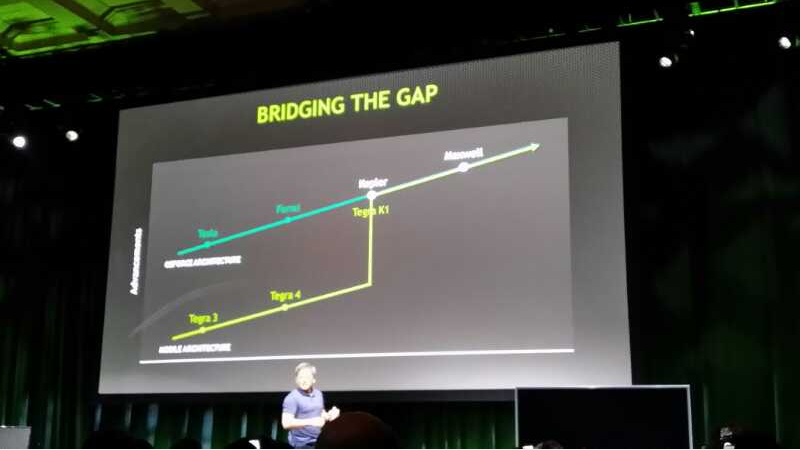NVIDIA, in a press event to kick off CES 2014, just announced the TEGRA K1, the world’s first 192-core “Super Chip.” We’re talking mobile architecture that’s as good as PC architecture.
At this point, we still don’t have devices that are running the processor, but we do have a bunch of demos. As you can imagine, the K1 is impressive on a number of levels. If you were looking for the ultimate gaming chip for mobile (or any platform for that matter), this would be it.
Look, this all sounds amazing – mobile devices on-par with PCs – but if we don’t get devices running this power on a mainstream level, it means nothing. Give us hardware partners. According to NVIDIA, we won’t see any devices running K1 until the first half of this year some time, and that’s only for the 32-bit version. the 64-bit version is “expected” to arrive some time in the second half of this year.
The live press event is still going on here, follow along as we update this post.
TEGRA K1 comes in two versions. First version is the quad-core A15, but the other version is “DENVER” CPU. It’s a full custom CPU, based on ARM V8 64-BIT.
According to the press release, we should see the 32-bit version in devices in the first half of 2014, while the 64-bit version is expected in devices in the second half of the year.
Press Release
NVIDIA Unveils Tegra K1, A 192-Core Super Chip That Brings DNA Of World’s Fastest GPU To Mobile
Kepler GPU Architecture in GeForce GTX 780 Ti Morphs Into Mobile Graphics Powerhouse; Available in 32- and 64-Bit Versions
LAS VEGAS, NV – CES — NVIDIA today unveiled the revolutionary Tegra® K1 mobile processor, a 192-core super chip featuring the same NVIDIA® Kepler™ architecture that powers the fastest GPU on the planet, the NVIDIA GeForce® GTX™ 780 Ti. For the first time, next-generation PC gaming will now be available on mobile platforms.
The Tegra K1 processor sets new mobile standards by supporting the latest PC-class gaming technologies, enabling it to run sophisticated gaming engines like Epic Games’ Unreal Engine 4. It delivers advanced computation capabilities to speed the development of applications for computer vision and speech recognition. And its extraordinary efficiency delivers higher performance than any other mobile GPU at the same power level.
“Over the past two decades, NVIDIA invented the GPU and has developed more graphics technologies than any other company,” said Jen-Hsun Huang, co-founder and CEO, NVIDIA. “With Tegra K1, we’re bringing that heritage to mobile. It bridges the gap for developers, who can now build next-gen games and apps that will run on any device.”
Tegra K1 is offered in two pin-to-pin compatible versions. The first version uses a 32-bit quad-core, 4-Plus-1™ ARM Cortex A15 CPU. The second version uses a custom, NVIDIA-designed 64-bit dual Super Core CPU. This CPU (codenamed “Denver”) delivers very high single-thread and multi-thread performance. It is based on the ARMv8 architecture, which brings the energy-efficient heritage of ARM processor technology to 64-bit computing.
Both versions of Tegra K1 deliver stunning graphics and visual computing capabilities powered by the 192-core NVIDIA Kepler GPU. The 32-bit version is expected in devices in the first half of 2014, while the 64-bit version is expected in devices in the second half of the year.
Simply Unreal:Setting Stunning New Gaming Standards
Tegra K1 provides full support for the latest PC-class gaming technologies — including DirectX 11, OpenGL 4.4 and tessellation. These capabilities will enable PC and console game developers to finally bring their stunning, visually rich titles to mobile devices.Such features enable Tegra K1 to run the world’s most advanced game engine, Unreal Engine 4. Unreal Engine is the most successful commercially licensed game engine, powering hundreds of games on high-end PCs and consoles.
Tegra K1 is also the first mobile processor to deliver the same graphics features as the next generation of consoles (Xbox One, PlayStation 4) and faster performance than current generation consoles (Xbox 360, PlayStation 3), all in the palm of your hand.
“With the introduction of this revolutionary processor, we can take applications that run on PC or console and run it on Tegra,” said Tim Sweeney, founder of Epic Games and developer of Unreal Engine. “From here onward, I think we’re going to see the performance and feature gap between mobile and PC high-end gaming continue to narrow to the point where the difference between the platforms really blurs.”
Computationally Advanced:Delivering New Creative Capabilities
Tegra K1 is the first processor to bring advanced computational capabilities to mobile — leveraging its advanced GPU to deliver new mobile experiences.It is also the first mobile processor to support NVIDIA CUDA® — the world’s most pervasive parallel computing platform. Developers have downloaded CUDA more than 2 million times to create cutting-edge GPU-accelerated applications for computer vision, advanced imaging, speech recognition, video editing and more.
Stunningly Efficient: Establishing New Benchmarks
In addition to its graphics and compute capabilities, Tegra K1 delivers breakthrough efficiency. The Kepler GPU at the heart of Tegra K1 is 1.5 times more efficient than other mobile GPUs. This results in faster performance in the same power envelope and a better experience for gaming and GPU-accelerated applications.(1)Kepler — first introduced in desktop and notebook systems, and later brought to workstations and supercomputers — is the world’s fastest and most energy-efficient GPU architecture. Tens of millions of Kepler-based graphics cards and systems have been shipped, including the GeForce GTX 780 Ti.
“Kepler powers all 10 of the world’s most energy-efficient supercomputers,” said Linley Gwennap of the Linley Group. “By scaling this technology down, NVIDIA has set the new standard for what’s possible in mobile devices.”
More details about the Tegra K1 are available at www.nvidia.com/object/tegra-k1-processor.html.
We’ll have more once NVIDIA releases full details.


Collapse Show Comments72 Comments